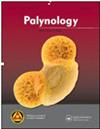Prestigious early Roman gardens across the Empire: the significance of gardens and horticultural trends evidenced by pollen
IF 1.3
4区 地球科学
Q3 PALEONTOLOGY
引用次数: 4
Abstract
Abstract The present study has two main goals. The first is to reconstruct the botanical components that grew in the impressive garden of Villa Arianna (Stabiae). The garden, which was extensively destroyed and covered by tephra ash in 79 CE, is considered the largest peristyle garden in the Vesuvian region. Its plants were revealed based on a unique palynological-archaeological method involving the extraction of pollen from plaster attached to structures that faced the garden. The second aim is to compare this prestigious garden with other early elite Roman gardens, located in the eastern part of the Empire, to trace the importation of plants, horticultural trends, etc. For this purpose, gardens of Herod the Great, the client king of Judaea, which the author recently studied palynologically (in Caesarea, Herodium and Jericho), were compared with the new pollen results of Villa Arianna. The comparison between the gardens’ botanical components and their different landscapes led to the following conclusions: (1) Plants were imported from both ends of the Empire as elite products (rather than cash crops). Hazelnut (Corylus) and cedar (Cedrus) were introduced from west to east, while the date palm (Phoenix dactylifera) was introduced along an east-west axis. (2) The gardening trend of tree dwarfism was observed both at Villa Arianna and Jericho. (3) The gardens flourished in challenging habitats. At Villa Arianna and Caesarea, efforts were devoted to sustaining splendid gardens in the relatively harsh, saline Mediterranean Sea environment; at Herodium and Jericho, special efforts were required for the success of Mediterranean plants in semi-arid climate. (4) Herod’s mausoleum garden in Herodium, whose dark evergreen trees on the whitish slopes of the artificial tumulus could be seen from the Temple in Jerusalem, may have been inspired by the architectural arrangement of the Pantheon and the Mausoleum of Augustus, the patron of Herod.帝国早期著名的罗马花园:花粉证明了花园和园艺趋势的重要性
摘要本研究有两个主要目标。首先是重建在Villa Arianna(Stabiae)令人印象深刻的花园中生长的植物成分。该花园在公元79年被火山灰广泛摧毁并覆盖,被认为是维苏威地区最大的潜望式花园。它的植物是根据一种独特的孢粉考古方法发现的,该方法涉及从附着在花园结构上的灰泥中提取花粉。第二个目的是将这个著名的花园与位于帝国东部的其他早期罗马精英花园进行比较,以追踪植物的进口、园艺趋势等。为此,作者最近研究了犹太客户国王希律大帝的花园(在凯撒利亚、希律王和杰里科),与Villa Arianna的新花粉结果进行了比较。花园的植物成分及其不同景观之间的比较得出了以下结论:(1)植物是作为精英产品(而不是经济作物)从帝国两端进口的。榛子(Corylus)和雪松(Cedrus)是从西向东引入的,而椰枣(Phoenix dactylifera)是沿着东西轴线引入的。(2) 在Villa Arianna和Jericho都观察到了树木矮化的园艺趋势。(3) 花园在富有挑战性的栖息地蓬勃发展。在Villa Arianna和Caesarea,他们致力于在相对恶劣、盐碱的地中海环境中维持辉煌的花园;在希罗迪姆和杰里科,地中海植物在半干旱气候中的成功需要特别的努力。(4) 希律王在希律殿的陵墓花园,从耶路撒冷的圣殿可以看到人工陵墓白色斜坡上的深色常青树,其灵感可能来自万神殿和希律王的赞助人奥古斯都陵墓的建筑布置。
本文章由计算机程序翻译,如有差异,请以英文原文为准。
求助全文
约1分钟内获得全文
求助全文
来源期刊

Palynology
地学-古生物学
CiteScore
3.40
自引率
26.70%
发文量
48
审稿时长
>12 weeks
期刊介绍:
Palynology is an international journal, and covers all aspects of the science. We accept papers on both pre-Quaternary and Quaternary palynology and palaeobotany. Contributions on novel uses of palynology, review articles, book reviews, taxonomic studies and papers on methodology are all actively encouraged.
 求助内容:
求助内容: 应助结果提醒方式:
应助结果提醒方式:


